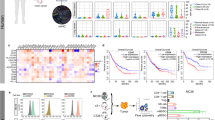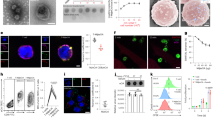Abstract
NDV as an attractive candidate for oncolytic immunotherapy selectively lyses tumor cells but shows limited anti-tumor immunity. Immune co-stimulator OX40 ligand (OX40L) boosts anti-tumor immunity response by delivering a potent costimulatory signal to CD4+ and CD8+ T cells. To improve the anti-tumor immunity of NDV, the recombinant NDV expressing the murine OX40L (rNDV-mOX40L) was engineered. The viral growth kinetics was examined in CT26 cell lines. The ability of rNDV-mOX40L to express mOX40L was detected in the infected tumor cells and tumor tissues. The anti-tumor activity of rNDV-mOX40L was studied in the CT26 animal model. Tumor-specific CD4+, CD8+ and OX40+ T cells were examined by immunohistochemistry staining. The virus growth curve showed that the insertion of the mOX40L gene did not affect the growth kinetics of NDV. rNDV-mOX40L expresses mOX40L and effectively inhibits the growth of CT26 colorectal cancer in vivo. The tumor inhibition rate of the rNDV-mOX40L-treated group was increased by 15.8% compared to that of NDV-treated group in the CT26 model. Furthermore, immunohistochemistry staining of tumor tissues removed from the CT26 model revealed that intense infiltration of tumor-specific CD4+, CD8+ T cells, especially OX40+ T cells were found in the rNDV-mOX40L-treated group. FACS showed that rNDV-mOX40L significantly enhanced the number of CD4+ and CD8+ T cells in spleen. Moreover, compared to the NDV-treated group, the level of mouse IFN-γ protein in the tumor site increased significantly in the rNDV-mOX40L-treated group. Taken together, rNDV-mOX40L exhibited superior anti-tumor immunity by stimulating tumor-specific T cells and may be a promising agent for cancer immunotherapy.
This is a preview of subscription content, access via your institution
Access options
Subscribe to this journal
Receive 12 print issues and online access
$259.00 per year
only $21.58 per issue
Buy this article
- Purchase on Springer Link
- Instant access to full article PDF
Prices may be subject to local taxes which are calculated during checkout







Similar content being viewed by others
References
Cassel WA, Garrett RE. Newcastle disease virus as an antineoplastic agent. Cancer. 1965;18:863–8.
Lam HY, Yeap SK, Pirozyan MR, Omar AR, Yusoff K, Suraini AA, et al. Safety and clinical usage of Newcastle disease virus in cancer therapy. J Biomed Biotechnol. 2011;2011:718710.
Omar AR, Ideris A, Ali AM, Othman F, Yusoff K, Abdullah JM, et al. An overview on the development of newcastle disease virus as an anti-cancer therapy. Malays J Med Sci. 2003;10:4–12.
Csatary SE LK, Bukosza I. Attenuated veterinary virus vaccine for the treatment of cancer. Cancer Detect Prev. 1993;17:619–27.
McCormack RM, Kaur B. Immune therapy, a double-edged sword for oncolytic viruses. Expert Opin Biol Ther. 2019;19:1111–3.
Fu Y, Lin Q, Zhang Z, Zhang L. Therapeutic strategies for the costimulatory molecule OX40 in T-cell-mediated immunity. Acta Pharm Sin B. 2020;10:414–33.
Sanmamed MF, Pastor F, Rodriguez A, Perez-Gracia JL, Rodriguez-Ruiz ME, Jure-Kunkel M, et al. Agonists of co-stimulation in cancer immunotherapy directed against CD137, OX40, GITR, CD27, CD28, and ICOS. Semin Oncol. 2015;42:640–55.
Ishii N, Takahashi T, Soroosh P, Sugamura K. OX40-OX40 ligand interaction in T-cell-mediated immunity and immunopathology. Adv Immunol. 2010;105:63–98.
Croft M. Control of immunity by the TNFR-related molecule OX40 (CD134). Annu Rev Immunol. 2010;28:57–78.
Schaer DA, Murphy JT, Wolchok JD. Modulation of GITR for cancer immunotherapy. Curr Opin Immunol. 2012;24:217–24.
Kjaergaard J, Tanaka J, Kim JA, Rothchild K, Weinberg A, Shu S. Therapeutic efficacy of OX-40 receptor antibody depends on tumor immunogenicity and anatomic site of tumor growth. Cancer Res. 2000;60:5514–21.
Moran AE, Kovacsovics-Bankowski M, Weinberg AD. The TNFRs OX40, 4-1BB, and CD40 as targets for cancer immunotherapy. Curr Opin Immunol. 2013;25:230–7.
Weinberg AD, Rivera MM, Prell R, Morris A, Ramstad T, Vetto JT, et al. Engagement of the OX-40 receptor in vivo enhances antitumor immunity. J Immunol. 2000;164:2160–9.
Gough MJ, Ruby CE, Redmond WL, Dhungel B, Brown A, Weinberg AD. OX40 agonist therapy enhances CD8 infiltration and decreases immune suppression in the tumor. Cancer Res. 2008;68:5206–15.
Piconese S, Valzasina B, Colombo MP. OX40 triggering blocks suppression by regulatory T cells and facilitates tumor rejection. J Exp Med. 2008;205:825–39.
Curti BD, Kovacsovics-Bankowski M, Morris N, Walker E, Chisholm L, Floyd K, et al. OX40 is a potent immune-stimulating target in late-stage cancer patients. Cancer Res. 2013;73:7189–98.
Wakamatsu N, King DJ, Seal BS, Samal SK, Brown CC. The pathogenesis of Newcastle disease: a comparison of selected Newcastle disease virus wild-type strains and their infectious clones. Virology. 2006;353:333–43.
Baum PR, Gayle RB, Ramsdell F, Srinivasan S, Sorensen RA, Watson ML, et al. Molecular characterization of murine and human OX40/OX40 ligand systems: identification of a human OX40 ligand as the HTLV-1-regulated protein gp34. EMBO J. 1994;13:3992–4001.
Jensen EC. Quantitative analysis of histological staining and fluorescence using ImageJ. Anat Rec. 2013;296:378–81.
Cardiff RD, Miller CH, Munn RJ. Manual hematoxylin and eosin staining of mouse tissue sections. Cold Spring Harb Protoc. 2014;2014:655–8.
Vigil A, Park MS, Martinez O, Chua MA, Xiao S, Cros JF, et al. Use of reverse genetics to enhance the oncolytic properties of Newcastle disease virus. Cancer Res. 2007;67:8285–92.
Sheridan C. First oncolytic virus edges towards approval in surprise vote. Nat Biotechnol. 2015;33:569–70.
Andtbacka RH, Kaufman HL, Collichio F, Amatruda T, Senzer N, Chesney J, et al. Talimogene Laherparepvec Improves Durable Response Rate in Patients With Advanced Melanoma. J Clin Oncol. 2015;33:2780–8.
Wu Y, He J, An Y, Wang X, Liu Y, Yan S, et al. Recombinant Newcastle disease virus (NDV/Anh-IL-2) expressing human IL-2 as a potential candidate for suppresses growth of hepatoma therapy. J Pharmacol Sci. 2016;132:24–30.
Hung K, Hayashi R, Lafond-Walker A, Lowenstein C, Pardoll D, Levitsky H. The central role of CD4(+) T cells in the antitumor immune response. J Exp Med. 1998;188:2357–68.
Waldmann TA. Cytokines in cancer immunotherapy. Cold Spring Harb Perspect Biol. 2018;10:a028472.
Durgeau A, Virk Y, Corgnac S, Mami-Chouaib F. Recent advances in targeting CD8 T-cell immunity for more effective cancer immunotherapy. Front Immunol. 2018;9:14.
Acknowledgements
This work was financially supported by the National Key R&D Program of China (2017YFD0501102).
Author information
Authors and Affiliations
Contributions
LT: conceptualization, methodology, validation, formal analysis, investigation, writing-original draft, visualization. DL: conceptualization, methodology, validation, supervision, resources, data curation. WX: methodology, project administration, funding acquisition, data curation. TL: validation, methodology, investigation. YC: validation, investigation. SJ: validation, software. HS: validation, investigation. KK: validation, investigation. ZW: project administration, funding acquisition. GR: methodology, resources.
Corresponding authors
Ethics declarations
Conflict of interest
The authors declare no competing interests.
Additional information
Publisher’s note Springer Nature remains neutral with regard to jurisdictional claims in published maps and institutional affiliations.
Rights and permissions
About this article
Cite this article
Tian, L., Liu, T., Jiang, S. et al. Oncolytic Newcastle disease virus expressing the co-stimulator OX40L as immunopotentiator for colorectal cancer therapy. Gene Ther 30, 64–74 (2023). https://doi.org/10.1038/s41434-021-00256-8
Received:
Revised:
Accepted:
Published:
Issue Date:
DOI: https://doi.org/10.1038/s41434-021-00256-8
This article is cited by
-
Current advances in microbial-based cancer therapies
Medical Oncology (2023)



